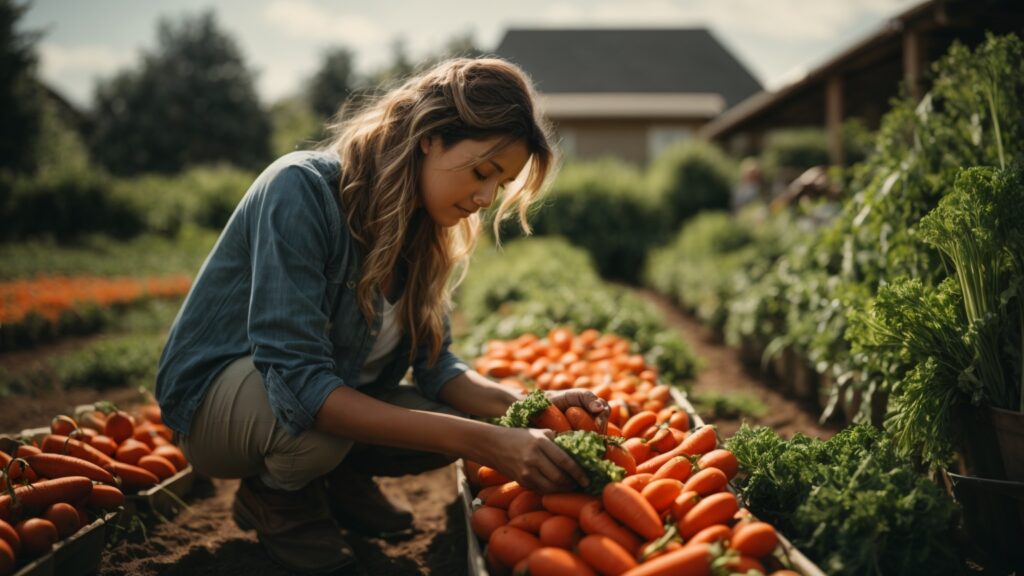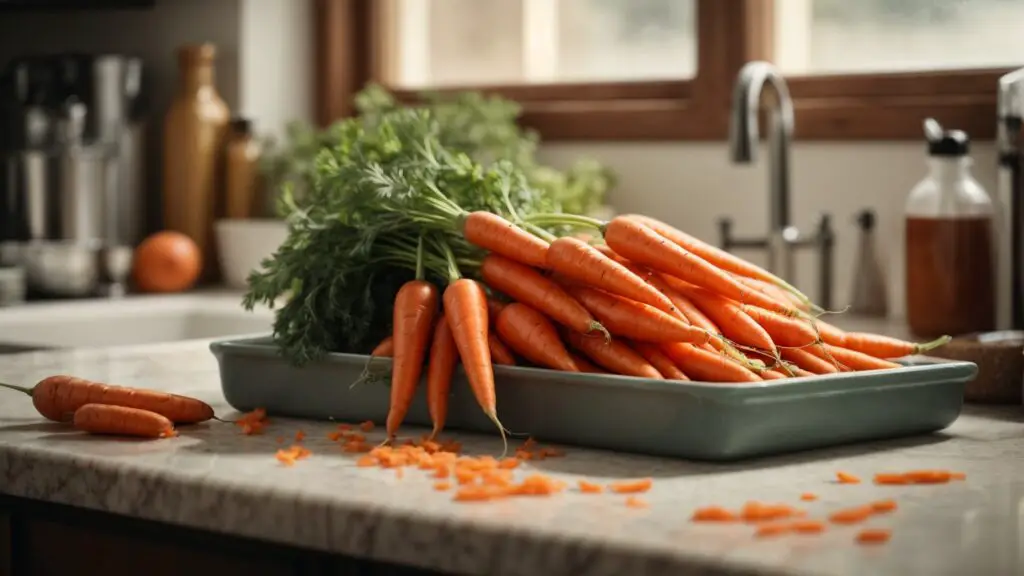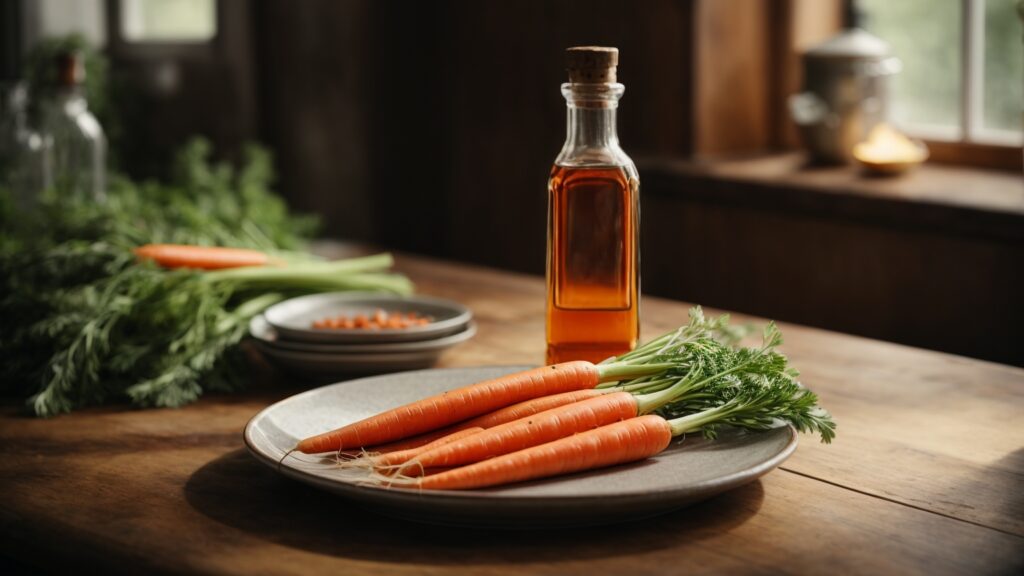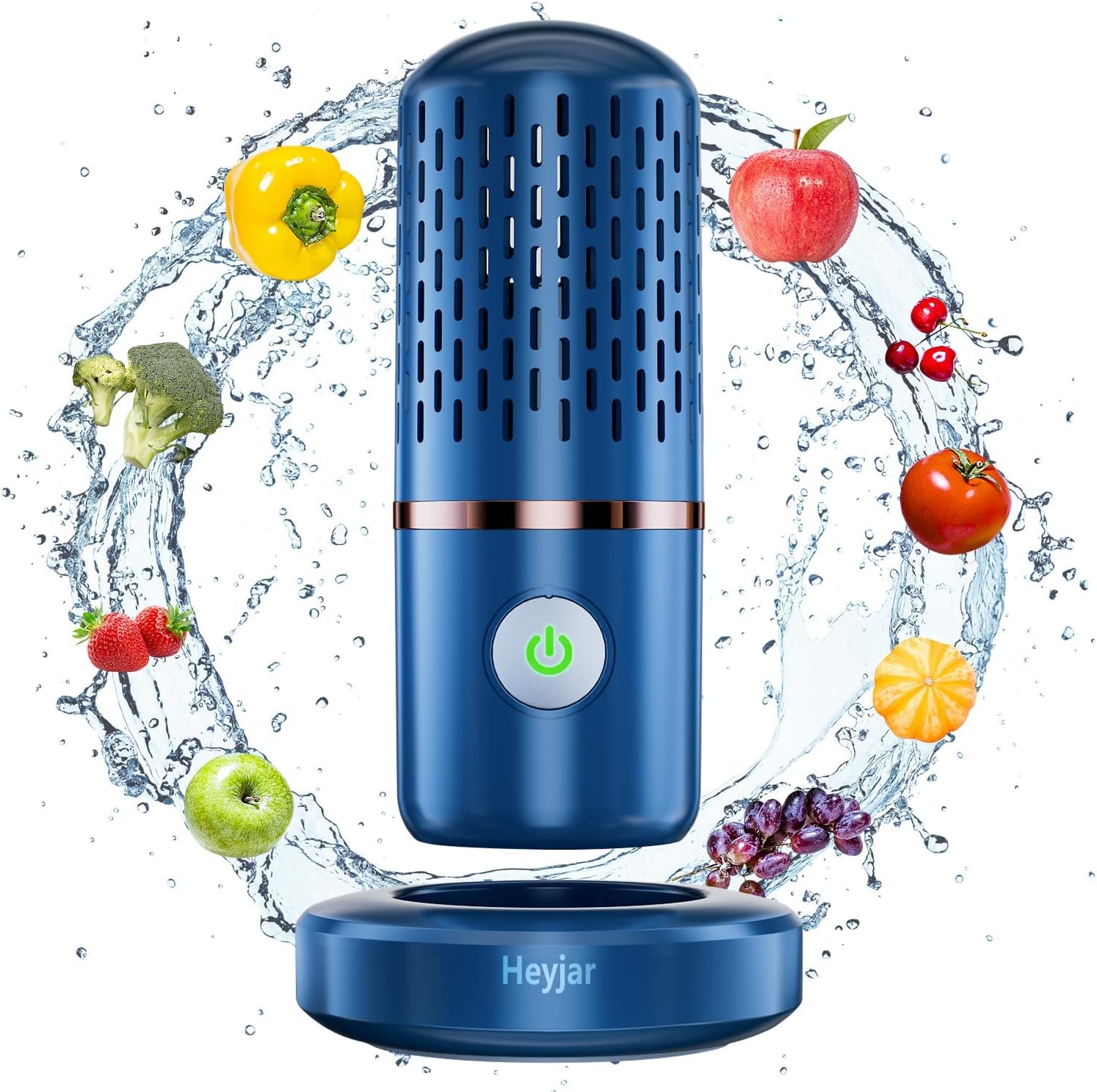Estimated reading time: 14 minutes
Introduction
Learning to clean garden carrots effectively is vital for anyone who enjoys these vibrant, nutritious root vegetables. Freshly harvested from the garden, carrots are often covered in soil and exposed to various microorganisms and potentially to pesticides or other chemicals. Understanding how to clean garden carrots properly is not just about ensuring their safety for consumption; it also significantly enhances their flavor and texture.
Throughout this guide, we’ll delve into different facets of cleaning garden carrots, ranging from the initial pre-wash handling to the best washing techniques and natural cleaning agents like vinegar and baking soda. We’ll also examine the pros and cons of peeling versus non-peeling methods and offer insightful tips for storing cleaned carrots in a way that preserves their freshness and nutritional value.
By the conclusion of this article, you will have a thorough understanding of how to clean garden carrots, ensuring they are safe and clean and retain their natural taste and nutritional benefits. Join us as we explore the essential steps and tips to make your garden carrots a safe, healthy, and delicious addition to your meals.
Key Takeaways
- Effective Cleaning Enhances Safety: Properly cleaning garden carrots removes soil, microorganisms, and potential chemical residues.
- Flavor and Texture Improvement: Clean carrots are safer to eat and have improved flavor and texture.
- Diverse Cleaning Techniques: Various cleaning methods, including baking soda and vinegar, offer effective ways to clean garden carrots.
- Peeling vs. Non-Peeling Debate: Understanding the pros and cons of peeling garden carrots can impact their nutritional value and taste.
- Storage Tips for Freshness: Proper storage methods for cleaned carrots are crucial for maintaining their freshness and nutritional benefits.
- Pesticide Mitigation Strategies: Employing specific cleaning techniques can help reduce the risks associated with pesticide residues on garden carrots.
Why Washing Garden Carrots Is Essential
When it’s time to prepare a fresh snack with garden carrots, the best way to clean them involves more than just rinsing. First, place your carrots in a large bowl of water. Clean your carrots thoroughly with a clean water rinse to start. Next, for any stubborn soil, use a vegetable brush to thoroughly scrub around the carrot. Unlike grocery store carrots which may have been pre-cleaned, growing carrots means soil and residues are likely. Once the carrots have come clean, pat them dry carrots thoroughly with a clean towel. Now, your carrots are ready and ready to use without any worries.
List of Reasons
- Health Benefits: Washing carrots removes harmful bacteria and potential pathogens from the soil, making them safer to consume.
- Texture Improvement: Clean carrots have a better texture, free from the grittiness that soil residues can cause.
- Pesticide Removal: For non-organic carrots, washing helps reduce the presence of pesticide residues, making them safer and healthier to eat.
The Impact of Soil and Microorganisms
Soil clinging to garden carrots can harbor various microorganisms, some of which can be harmful if ingested. This makes thorough washing a matter of cleanliness but also of health and safety.
Case Study: Studies comparing washed and unwashed carrots have shown significant differences in bacterial load and pesticide residues, highlighting the effectiveness of proper washing techniques.
Nutritional Aspects of Clean Carrots
Washing carrots properly helps maintain their nutritional integrity. The cleaning process does not strip away essential nutrients but ensures that the carrots are consumed healthily.
Safety Concerns with Unwashed Carrots
Unwashed garden carrots pose a risk of foodborne illnesses due to soil-borne bacteria. This section emphasizes the importance of washing carrots to avoid health risks associated with consuming unwashed produce.
The process of washing garden carrots is critical for multiple reasons: enhancing safety, improving texture, and ensuring the nutritional benefits of these root vegetables are fully realized. This section has highlighted the pivotal role of proper carrot cleaning in any healthy kitchen.
Pre-Wash Handling: Best Practices To Clean Garden Carrots
Before delving into how to clean garden carrots, it’s crucial to understand the best practices for pre-wash handling. This initial step is often overlooked but is vital for ensuring the overall quality and safety of the carrots.
Table: Steps for Pre-Wash Handling of Garden Carrots
| Step | Description |
|---|---|
| Harvest Carefully | Gently pull carrots from the ground to avoid bruising. |
| Remove Excess Soil | Shake off loose dirt but avoid rigorous scrubbing at this stage. |
| Trim Tops | Cutting off the green tops prevents moisture loss and preserves freshness. |
| Dry Storage | Store unwashed carrots in a cool, dry place if not washing immediately. |
Harvesting Tips
The key to preserving the quality of garden carrots starts right from the harvest. Use gentle methods to extract the carrots to minimize damage to the skin, which can affect texture and flavor.
An expert gardener advises, “Handle your garden carrots with care right from the moment of harvest. This careful handling is as important as the washing process itself.”
Case Study: A study comparing different pre-wash handling methods found that carrots handled gently and stored properly before washing had a longer shelf life and retained better texture and flavor.
Proper pre-wash handling of garden carrots is an essential step in the cleaning process. It sets the stage for effective cleaning and plays a significant role in maintaining the carrots’ quality, freshness, and nutritional value. By following these best practices, you ensure that your garden carrots are clean and of the best possible quality.

Effective Washing Techniques To Clean Garden Carrots
To ensure well-cleaned carrots that are ready to eat, start by holding each carrot under running water. For dirt lodged in the crevice of the carrot and scrub with a scouring pad; you don’t need harsh chemicals like bleach. Give them a good scrubbing, focusing on the porous skin and make sure all dirt is removed, as this will help prevent ethylene gas from fruits and vegetables in your compost from affecting them. After washing, these steps not only prepare your carrots for storing fresh but also make them perfect for recipes like carrot cake.
Different Methods and Their Effectiveness
- Running Water Rinse: Simple yet effective, especially for lightly soiled carrots.
- Vegetable Brush Scrubbing: Ideal for removing stubborn soil and ensuring deep cleaning.
- Soaking in Water: Useful for loosening dirt and debris before scrubbing.
- Vinegar or Baking Soda Wash: Helps in reducing pesticide residues and killing bacteria.
Manual vs. Machine Washing
Comparing manual and machine washing, manual methods, such as hand scrubbing with a vegetable brush, are often more thorough, especially for irregular-sized garden carrots. Machine washing can be useful for large batches but might not be as effective for deep cleaning.
Water Temperature and Pressure Considerations
The temperature and pressure of the water used for washing carrots play a crucial role. Cold water is generally recommended to preserve the carrot’s crispness, while moderate pressure ensures effective cleaning without damaging the carrot’s skin.
A professional chef shares, “The secret to perfectly clean garden carrots lies in the gentleness of your washing technique. A gentle scrub under running water can work wonders.”
The best washing techniques for garden carrots involve a combination of methods, depending on the soil level and type of carrots. Each method has its merits, and often a combination yields the best results. This section underscores the importance of choosing the right technique to ensure your garden carrots are visually appealing, clean, and safe for eating.
Using Baking Soda for Deeper Cleaning
Baking soda is a powerful, natural cleaning agent that offers significant benefits when cleaning garden carrots. Its gentle abrasive action and natural deodorizing properties make it an excellent choice for deeper cleaning, ensuring that your carrots are clean and free of any unpleasant odors.
How Baking Soda Works on Dirt and Residues
With its mild alkaline nature, baking soda effectively breaks down dirt and residues on the carrot’s surface. This makes it particularly useful for removing stubborn soil and potentially harmful substances that water alone might not eliminate.
DIY Baking Soda Wash Recipes
Creating a DIY baking soda wash is simple and cost-effective. You can make a paste with water for scrubbing or a soaking solution by dissolving baking soda in water, providing a versatile approach to cleaning carrots.
Step-by-Step Guide to Using Baking Soda
- Prepare the Solution: Dissolve 2-3 tablespoons of baking soda in a gallon of water.
- Soak the Carrots: Submerge the garden carrots in the solution for 5-10 minutes.
- Gentle Scrubbing: Use a soft brush to scrub the carrots gently.
- Rinse Thoroughly: After scrubbing, rinse the carrots under clean running water.
- Dry Completely: Pat the carrots dry with a clean towel or let them air dry.
Comparison of Effectiveness with and without Baking Soda
| Method | Effectiveness in Cleaning | Residue Removal |
|---|---|---|
| Water Only | Good for light soil | Minimal |
| Baking Soda Solution | Excellent for deep cleaning | High |
Testimonials on Baking Soda Use
Many gardeners and chefs have praised the effectiveness of baking soda in cleaning garden carrots, noting a significant difference in cleanliness compared to just using water.
An experienced organic farmer shares, “Using baking soda for cleaning carrots is a game-changer. It’s natural, effective, and leaves the carrots spotless and ready for cooking or raw consumption.”
Using baking soda for cleaning garden carrots is advantageous, providing deep cleaning capabilities while being gentle and eco-friendly. This section highlights the effectiveness of baking soda, offering a practical and efficient way to clean garden carrots thoroughly.

The Role of Vinegar to Clean Garden Carrots
Vinegar is a versatile and natural cleaning agent, highly effective in cleaning garden carrots. Its acidic properties make it excellent for removing dirt and potentially harmful residues, ensuring the carrots are clean and safe for consumption.
Case Study: Studies have shown that a vinegar wash can significantly reduce the presence of bacteria and pesticides on garden carrots, making it a preferred choice for organic and health-conscious gardeners.
Preparing a Vinegar Wash
Preparing a vinegar wash is simple: mix equal water and vinegar, and soak the carrots for about 10 minutes. This solution is effective in loosening soil and eliminating surface contaminants.
Vinegar’s Properties in Cleaning
The acetic acid in vinegar acts as a natural disinfectant, breaking down dirt, bacteria, and chemical residues. This makes it an effective and safer alternative to commercial cleaners, especially for edible produce like carrots.
Vinegar vs. Other Cleaning Agents
| Cleaning Agent | Effectiveness | Safety for Consumption |
|---|---|---|
| Water Only | Moderate | Very Safe |
| Vinegar Wash | High | Very Safe |
| Commercial Cleaner | High | Variable |
User Experiences with Vinegar
Many users have reported that cleaning garden carrots with vinegar leave them feeling brighter and cleaner. It’s preferred for those who want a natural and effective solution.
An organic farmer says, “I always use a vinegar wash for my garden carrots. It’s natural, effective, and I know I’m not adding any unwanted chemicals to my produce.”
Vinegar plays a significant role in the effective cleaning of garden carrots. Its natural disinfectant properties, ease of use, and availability make it a valuable tool in any gardener’s cleaning arsenal. This section highlights the benefits of using vinegar, not just for its cleaning power but also for the peace of mind it offers regarding food safety.
Peeling vs. Non-Peeling Methods
The debate between peeling and not peeling garden carrots is significant in both culinary and nutritional circles. This section explores the various aspects of this debate, helping readers make an informed decision about their approach to preparing carrots.
Case Study: A comparative analysis of peeled versus non-peeled carrots reveals differences in taste, texture, and nutrient retention, providing valuable insights into the impact of each method.
Pros and Cons of Peeling
Pros: Peeling removes residual soil and reduces pesticide exposure, especially in non-organic carrots. It also results in a smoother texture, preferred in certain recipes.
Cons: Peeling can lead to the loss of valuable nutrients and fiber found just beneath the skin.
Factors to Consider in Deciding to Peel or Not
- Purpose of Use: Whether the carrots are for raw consumption, cooking, or juicing.
- Carrot Variety: Some varieties have thinner skins that are more palatable when unpeeled.
- Personal Preference: Texture and aesthetic preferences play a role in the decision.
Impact on Texture and Taste
Peeling can affect the carrot’s texture, making it more tender, while non-peeling retains a more natural and earthy texture. Taste-wise, unpeeled carrots can have a more robust flavor.
Nutritional Differences
The skin of carrots is rich in nutrients and fiber. Peeling can remove some of these beneficial elements, though the core of the carrot still remains nutritious.
Making an informed choice about peeling garden carrots depends on various factors, including the intended use, nutritional considerations, and personal preferences. This section provides a comprehensive overview, empowering readers to choose the method that best suits their needs and ensures they get the most out of their garden carrots.

Storing Clean Garden Carrots: Tips and Tricks
After cleaning garden carrots, it’s essential to store them correctly to maintain their freshness and nutritional value. This section provides best practices for storing cleaned carrots, ensuring they stay crisp and delicious for as long as possible.
Various Storage Methods
- Refrigeration: Store in the crisper drawer of your refrigerator in a perforated plastic bag.
- Dry Storage: Keep them in a cool, dry place for short-term use.
- Freezing: Blanch carrots before freezing to preserve texture and flavor.
- Root Cellaring: A root cellar or similar cool, dark environment is ideal for long-term storage.
Refrigeration Techniques
For most households, refrigeration is the best method. Storing carrots in a crisper drawer, ideally in a perforated plastic bag, helps maintain humidity and keeps them fresh.
Storage Duration and Conditions
| Storage Method | Duration | Conditions |
|---|---|---|
| Refrigeration | Up to 3 weeks | In a crisper drawer, high-humidity |
| Dry Storage | A few days | A cool, dark place |
| Freezing | Up to 12 months | Blanch before freezing |
| Root Cellaring | Several months | A cool, dark, and humid environment |
Tips for Long-Term Storage
For long-term storage, carrots can be blanched and frozen or stored in a root cellar. These methods help retain the carrots’ texture and nutritional quality over extended periods.
Effectively storing cleaned carrots is key to maximizing their shelf life and preserving quality. Whether you choose refrigeration, freezing, or cellaring, these tips and tricks will ensure your garden carrots remain fresh and nutritious, ready for your next culinary creation.
Mitigating Pesticide Risks
Understanding the risks associated with pesticides on carrots is crucial, especially for garden carrots that might have been exposed to various treatments. This section addresses how to effectively mitigate these risks to ensure the carrots are safe for consumption.
Strategies for Reducing Pesticide Residues
- Thorough Washing: Use clean water and a vegetable brush to scrub the carrots thoroughly.
- Soaking in Solutions: Soak carrots in a mixture of water and a natural cleaning agent like vinegar or baking soda.
- Peeling: Removing the outer skin can help reduce pesticide residues, though it may also remove some nutrients.
- Choosing Organic: Opting for organic carrots can be a way to avoid pesticide exposure from the start.
Organic vs. Conventional Carrots
The difference between organic and conventional carrots regarding pesticide exposure is significant. Organic carrots are grown without synthetic pesticides, making them safer for those concerned about chemical residues.
An agricultural scientist notes, “While washing can reduce pesticide levels, the best way to avoid these chemicals is to choose organic carrots whenever possible.”
Home Remedies for Pesticide Removal
Home remedies, such as soaking carrots in vinegar, can effectively reduce pesticide residues. These methods are simple, accessible, and use everyday household items.
Importance of Thorough Cleaning
Whether the carrots are organic or conventionally grown, thorough cleaning remains crucial. It helps in not just removing dirt and debris but also in reducing pesticide residues significantly.
Mitigating pesticide risks on garden carrots involves thoroughly washing, considering organic options, and using natural cleaning methods. By following these strategies, you can enjoy your garden carrots with the assurance that you’ve reduced the exposure to potentially harmful pesticides.
- Aquapur Fruit Cleaner Device
- Fruit Purifier
- OH-ion Purification Technology
- Cleaning Fruit,Vegetable,Rice
- Tableware (Blue)
Conclusion
In wrapping up our simple guide on how to clean garden carrots, it’s evident that the steps involved are crucial not just for safety but for the quality of the veggies. From the initial harvest carrots from your carrot patch, where size and shape influence the ease of cleaning, to the actual washing, every step matters. Scrubbing carrots with a vegetable scrubber is an effective way to ensure that any dirt and microbes clinging to their surface are thoroughly removed, making them safe and appealing to eat.
Storage also plays a key role in keeping your homegrown carrots fresh. Step 1 involves drying the carrots completely before storing them; this prevents them from becoming spoil. Step 2 is storing them properly, ideally away from apples and pear, as these emit ethylene gas that can cause other produce, like carrots, to deteriorate faster. Understanding these factors and implementing them in your gardening and kitchen routines can significantly enhance your experience with grow at home carrots. This guide serves as a good indicator of when it’s time to start using proper techniques to clean and store carrots, ensuring they remain a healthy, tasty part of your diet.

James Dunnington leads the James Dunnington Collection, featuring five unique blogs: a practical Pet Care Guide, an enlightening Ancient History Blog, a resourceful Home Improvement Guide, a cutting-edge Tech Innovation Guide, and a strategic Online Money Making platform. Each site delivers valuable insights designed to empower and inform. For updates and more tips, visit our Contact Us page to sign up for our newsletter, ensuring you never miss out on the latest content from any of these dynamic fields.

